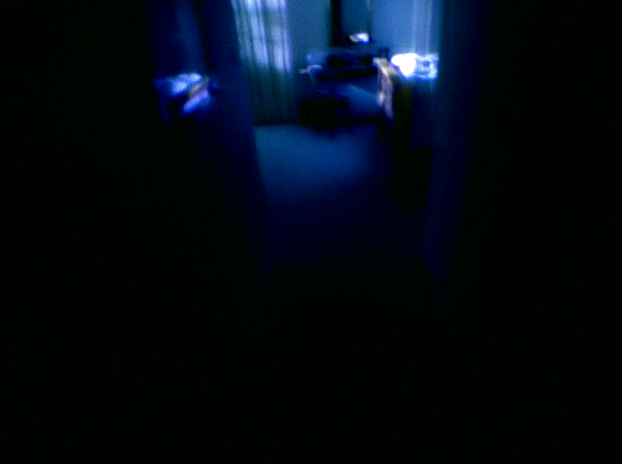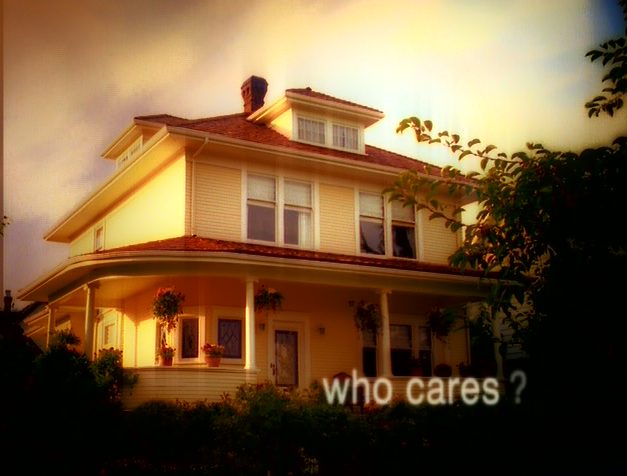One of the most beautiful introductory montages ever devised for television comes from Chris Carter's Millennium (1996 - 1999). In part this is so because the Millennium montage plays more like a disturbing dream...or vision of an uncertain future.
The emotional theme song by Mark Snow is heavy on violins, and seems to feature a sense of grievous, portentous sadness, even as an occasional and hard two-beat strike drives the composition forward.
Those two repeating beats -- thump, thump -- remind us that there is danger here, as well as the feelings of sadness about the shape of things to come.
The overriding feeling expressed in the theme song, and in the imagery featured below, is what I have termed (vis-a-vis Chris Carter's TV work...) anticipatory anxiety.
In other words, the viewer can't escape the feeling that something terrible is going to occur.
In the moment, all seems well, but the moment is fading...fast.
In 1996, the very title of this series, Millennium, put a specific date on the approaching doomsday: the year 2000. Accordingly, this introductory montage obsesses on images of autumn, sunset, darkness, and danger looming.
The first images we see in the montage are of golden sunset. A female figure stands silhouetted before apricot sunlight.Surrounding her on three sides is a black arch, an edifice which suggests (like the sunset...) encroaching darkness. In other words, the female figure's space in the frame is limited, cut off. It's as if an umbrella of darkness hangs over her.
The figure in this image then undergoes a transition. She goes from standing up-right to slumping, as if the weight of the world -- or some terrible event -- is pushing her down. She has been, for lack of a better word, defeated.
In the next few shots, sunlight itself seems to vanish.
Suddenly, we are in the dark, seeing disconnected -- but frightening -- images in blue-and-silver tones of night.
One disturbing shot shows a groping hand reaching out from behind an unlocked door.
The dis-mantled locking device and key-hole are apparent in the frame too. The inference is that this person (or thing) was locked inside some place, kept out of sight.
To me, these images suggest a terror being unleashed....a door opening, a mystery unveiled. The darkness is free now.
The next image in sequence follows on that idea. It is a film noir-styled composition of another silhouetted figure, this one walking through pounding rain.
Since it comes soon after the preceding image of a door being opened, we can intuit that this image represents the Evil Unloosed Upon Us, on our streets.
The fact that the Evil is a shadow is important, I submit. At this point, we don't quite know what shape the evil or disaster will take, but we know it stalks us. The terror is still anonymous, undefined.
But the creature walks among us.
Next there's a quick cut of a woman's naked legs. Her hands are held together (as if in prayer...or perhaps merely submission...), between her tightly-braced legs. This positioning of the body -- as well as the surfeit of nude flesh -- suggests to me embarrassment, shame, guilt, or even defensiveness in the face of a monster.
There's the suggestion, then, that the Dark Shadow that consumes us all may emerge from our Id; from human sexuality or other instincts.
The next image is of a dark room, with the windows left conspicuously open at night-time.
White drapes flutter uneasily in the breeze. An ill-wind blows...
Once more, the image hones in on this atmosphere of creeping dread, on anticipatory anxiety.
We are vulnerable, this image tells us. We have left open our windows at a time of danger, and are totally unaware of what horrors await.
A human skull burns in the follow-up imagery, a representation, I believe, of what we all fear most: that our way of life is going to die horribly. Our world is going to go up in flames. Humanity is burning.
Again, the feeling is that we are on the verge of a terrible event or apocalypse. Could it be nuclear in nature?
As disaster looms, the road ahead is unknown. How do we avert the crisis? Stay in the same lane? Change lanes? What course do we take?
Can we run away from the Evil?
Once more, the montage features a short view that seems to overtly involve sexuality (and hence morality).
A female figure uses what appears to be a straight razor to cut through her garb, her white clothing.
If the white clothing represents purity, then its tearing asunder represents the approaching "stain" or disaster.
The aura of anticipatory anxiety is firmly established once more in the next shot.
A car head-light goes dark...as if the battery has died (a forecast, perhaps of Y2K and the fear of power grids failing...).
Then, the legend "wait" appears. It seems to tell us that something bad is approaching, and there's nothing we can do about it. The terror will arrive in its own time. Waiting is, apparently, our only option.
Next, we get another shot of a stranger moving alone, unnoticed, in our society, positioned against a fence.
The imagery is of an interloper on the perimeter, trying to find away in.
The follow-up image is the second one in the introductory montage that includes a razor. Here, the cast-off razor may have been used in a suicide attempt.
At least that's the immediate "resonance" it produces in me. Once more, there seems to be the idea encoded in the montage of sin, or guilt, or shame.
In the next two shots of the Millennium montage, something truly horrific occurs.
The "stranger" or interloper gains access to the fortress -- to our home (or, writ large, to America itself).
We see the silhouetted stranger push open a door, and enter a suburban bed-room.We adopt his point of view as he approaches a home's master bedroom, a symbol, perhaps, of sexuality or morality, again.
We seem to be stalking a shadowy woman in the next shot as the legend "worry" appears on screen. This word is yet another symbol of an overwhelming sensory fear, this anticipatory anxiety.
In this case, the woman -- whose face remains unseen -- walks towards the light, but the position of the shot reveals important information that she does not have access to.
We are watching her from the bushes. We are spying on her. The evil is ready to jump, to reveal itself...and she is unprepared.
Then comes the kicker and a sort of "reverse:" we get a foggy, out-of-focus shot of a woman or child holding her head, as if in pain or torment.
The villain we were expecting is exposed...and it may be us.
It could be our very thoughts and fears.
We are anticipating pain and suffering...but are we also creating it?
Next, we discover the antidote to this culture of fear.
Bathed in light, we see profiler Frank Black (Lance Henriksen). He wears a white shirt (proof of his immaculate morality and stature...), and a beatific expression, as he puts his adoring child to bed. He is our guardian and protector, our shepherd through these dark times.
The second such figure is Katherine, who is also bathed in white light. She looks radiant.
Together, the Blacks are a couple, and parents...the head of a family unit.
And if there is darkness looming outside our walls -- or on our country's perimeter -- then our salvation will arise where the danger strikes: in the family hearth.
The title card that credits Chris Carter appears next, and it showcases what is perhaps my favorite image from the Millennium montage.
A child (a surrogate for Jordan Black?) walks uneasily upon a high roof. We watch her from a low-angle, so she seems very far away, and quite high up.
It's as though she's navigating a balance beam. There's a "pillar" -- a light post -- behind her, and craggy branches ahead of her in the frame. These objects bracket her. Her positioning between them is vital.
It's as if this image conveys the notion that we have moved past our traditional pillars (nationalism, faith in leaders, faith itself...) and crossed into dangerous, uncharted, territory.
This child is walking a balance beam into a precarious, irregularly-shaped future.
Again, anticipatory anxiety is the phrase which best captures the feeling.
Finally, the montage ends with our place of safety: Frank Blacks beautiful yellow house.
This is sanctuary; this is safety.
But the appearance of the legend "who cares?" is troublesome.
The answer to the question "who cares?" may be, simply, Frank Black. He cares.
Or it could be the final punctuation of a sentence (and montage) about anticipatory anxiety.
The world is ending. The dark shadow is free. We are waiting and we are worrying, but what else are we doing to forestall the end?
Is everyone so distracted that they can't detect the looming danger?
If so, then the idea here is simply that something bad is coming...and nobody cares. Nobody can be bothered to stop it.
Taken together, The Millennium montage is beautifully filmed and scored, and captures perfectly the essence of the Chris Carter aesthetic.
We are all feeling fear about something (conspiracies? government? the year 2000? aliens?) but we are also experiencing the dot.com boom, enjoying the Internet, and living a post-Cold War peace.
Can that peace last?
Millennium -- and its gorgeous but discomforting introduction montage -- showcases the idea that the wolf is already at our door...and perhaps inside the house.





























There was a good documentary about the montage on the DVD set. A haunting experience every time before a new episode. I think I never skipped it.
ReplyDelete-T.S.